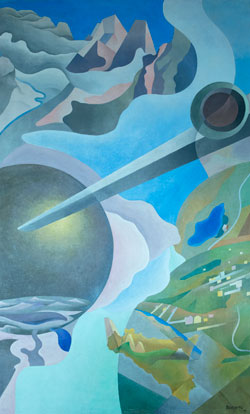Italian Futurism: Reconstructing the Universe, Guggenheim Museum
By Caroline Birenbaum
 |
Synthesis Of Aerial Communications (Sintesi Delle Comunicazioni Aeree), 1933–34 (Photo: Agr/Riccardi/Paoloni)
© Benedetta Cappa Marinetti, Used By Permission Of Vittoria Marinetti And Luce Marinetti’s Heirs |
Five years in the making, the first complete presentation of Italian Futurism in the United States, on view at the NY Guggenheim Museum until September 1, rewards repeat visits.
The avant-garde European literary and artistic movement was launched in 1909 by Filippo Tommaso Marinetti, a cosmopolitan poet with a bent for publicity and a desire to see Italy achieve primacy in the modern world, and lasted until his death in 1944.
Inspired by the sense of speed introduced by the automobile and other modern inventions appearing in the more developed Italian cities, he issued a dramatic Manifesto calling for an approach to literature befitting the new world of noisy, dynamic and constant change. Then, in 1912, venturing beyond “free verse,” Marinetti introduced the idea of “free words,” dispensing with syntax, punctuation, even meaning, to play with pure sounds and create word-drawings to be read as literature, experienced as visual art, and performed as dramatic works. He repeatedly declaimed his Zang Tumb Tuuum, a sound poem about an artillery battle, at interactive theatrical events designed to bring attention to the movement.
In 1910, a group of painters drafted their futurist manifesto, and in the following years, practitioners in many other fields followed suit. (The current exhibition title derives from a 1915 manifesto by the artist/designers Depero and Balla.) In 1913, a traveling exhibition made its way to cities in Europe as well as to London, to mixed critical response. Marinetti worked tirelessly, and successfully to spread the movement throughout Italy. Both cultural politics and national politics become complicated, especially as regards the relationship of some Futurists to Fascism; these aspects are beyond the scope of this article, but worthy of examination.
The exhibition is organized chronologically. Starting at the bottom of the ramp and spiraling around the entire rotunda, it culminates at the very top in spacious rooms not usually open to the public. Encompassing more than 360 works in many mediums, it is divided into manageable sections that are introduced by well-written wall text.
The first phase of Futurism, concluding with the end of World War I, is better known outside of Italy than subsequent developments. The artists chose industrial, public subjects, often reveling in nocturnal urban scenes illuminated by electric light, and strove to envelop viewers in the action depicted. You may recognize works on loan from New York museums, and perhaps appreciate them more fully in the context of this exhibition.
Less familiar are multi-exposure photographic studies, numerous publications, “music” of noise machines, film clips and audio tracks, striking conceptual architectural drawings that prefigure Art Deco buildings, a suite of dining room furniture, ceramics, clothing and costume design, and a light show to accompany a Stravinsky score.
One of the revelations to New York viewers is the versatile artist, Fortunato Depero, who painted, engaged in inventive theatrical productions, designed advertising for well-known firms such as Campari, created book jackets, magazine covers, textile designs, and more. Among his most delightful pieces are a scale model of a display pavilion he designed for a publishing house based on the company’s name and logo, decorative men’s vests, wooden toys, and a ballet performed by puppets rather than human dancers.
The last section, which is dominated by paintings and aerial photographs of spiraling flight, fits especially well with the architecture of the Guggenheim Museum.
The exhibition concludes with five splendid murals by Benedetta Cappa Marinetti that have decorated the elegant conference room of the main post office in Palermo, Sicily since their creation 80 years ago. These “Syntheses of Communications” are prescient, speaking even today to our wireless world. These paintings are probably the most significant loan to the exhibition, which features works by about 80 artists and writers, from more than 50 identified public and private European and American collections, and others who prefer anonymity.
The museum provides much background information. Staff members are eager to engage viewers in conversation. Display copies of the beautifully designed and very informative catalogue can be consulted at several levels of the ramp, and a large study room with reference material is located just beyond the final gallery.
For further information, public programs, and the highly regarded new Guggenheim app, go to www.guggenheim.org.#
